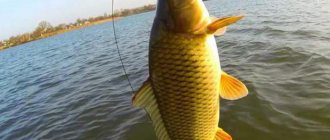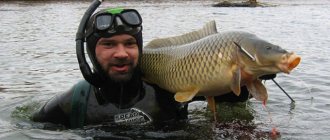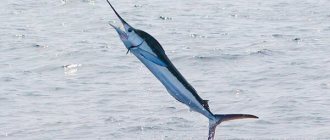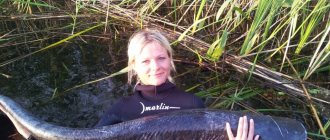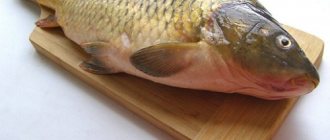Many inhabitants of ponds and lakes can be successfully caught from the shore with a fishing rod, but for example, underwater hunting for carp requires special preparation. Carp is a cautious fish and likes to create a cloudy cloud on the water, thereby confusing its movements, so you need to think about equipment and a wetsuit.
When hunting underwater, you can’t do without a good underwater gun. It is better to hunt in the morning, while the water is crystal clear. Closer to lunch, fishing may become uncomfortable; the carp simply will not notice the bait and will swim past, because... the reservoir will be visible to a depth of no more than 1 m.
Features of hunting underwater
You need to prepare in advance for fishing. When hunting carp, it is advisable to study:
- Habits of fish. Carp are found closer to the bottom, so even before diving into the water you need to decide on the place where the fish will gather. It happens that a fish literally jumps out of the water, creating muddy circles on the surface or, conversely, digs holes in the depths of the water, raising a cloud of turbidity. Even if he leaves this place, he will most likely return again in the evening, and there are brothers nearby.
- Terrain. Favorite places for entire groups of individuals: flooded bushes, snags, sedge. The ideal place is considered to be reed beds, where fish like to bask and bask and swim into the reed trunks. This is where you can watch for large specimens, especially if the water depth does not exceed 3 m. The main thing is not to yawn, take aim in time and prepare for the shot.
Catching carp on a donk
The oldest and most popular fishing method today is carp fishing with a donk. This method does not require expensive equipment, and the result exceeds all expectations. Donka is easy to use and make. It consists of a fishing line, no more than 0.4 mm thick, a sinker, hooks and leashes.
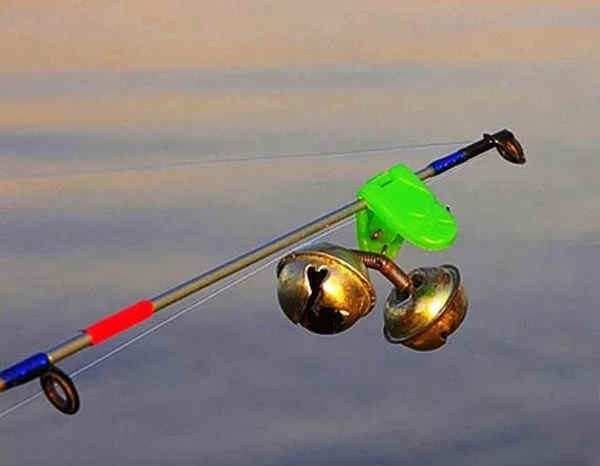
For a bite alarm, a bell is used, which is attached to the end of a fishing rod or fishing line.
Unlike feeder fishing, a feeder on a bottom is not a golden rule, but its presence is welcome. Cake, steamed grains of rye, barley and other crops are perfect as bait. When fishing, it is useful to throw complementary food into the pond: porridge, corn, corn or boiled potatoes, bread or peas, but you should remember that carp does not like canned peas.
Before you start fishing, you should feed the place. The food should be distributed over 3-4 square meters; it should not be thrown in a single lump, as this will not give the desired result.
For ease of casting and casting distance, a strong rod about two meters long is suitable. The length of the fishing line is selected individually by each fisherman and depends on the place where the fishing will take place. A small weight is suspended at its very end, and just above it there is a leash with several hooks. Braid and Kevlaron thread are used as a leash. Fishing can be done from a boat.
Basic equipment requirements
The equipment must be durable, lightweight, and have excellent penetrating power. When hunting carp, powerful, small-sized pneumatics are suitable. Some fishermen prefer to hunt with a crossbow or spear, but aiming in reed thickets is inconvenient and you can quickly miss your prey. If a harpoon is used, it must be sharp, with large notches, so that it can penetrate thoroughly into the body of the carp. Also, when choosing a speargun, it is important to consider:
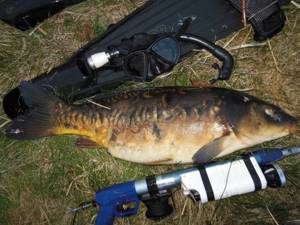
- Weight of the expected carp;
- Weather;
- Atmospheric pressure, because with sudden changes in pressure, the fish begins to sink to the bottom into cooler waters and prefers to remain at great depths to wait out the bad weather;
- Temperature regime.
Equipment should be selected taking into account the following parameters:
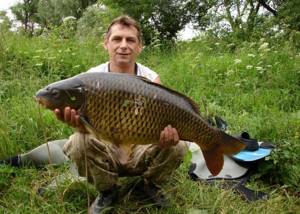
- Power, because carp have a fairly durable scaly covering, similar to armor. The weapon must be powerful, and it is better to aim at the gills;
- Shock absorption and it is advisable to equip the gun with a shock absorber or reel to withstand the powerful initial jerks of the fish. In the video you can better see how underwater hunting for carp takes place;
- Length, it is better to select a gun with a barrel up to 70 cm long in order to be able to pierce through carp and comfortably hunt in thickets of reeds and water lilies;
- Sharpness, when hunting with a spear, you need to thoroughly sharpen the tip so that it serves as a real sharpening for better penetration into the body of the fish and reducing the likelihood of escapes.
About successfully catching wild carp
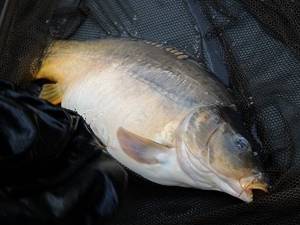
There is no children's hubbub, no sparrows can be heard, but good-quality dams remain on local rivers and streams, and in these dams, like splashes of former abundance, there are wild carp.
In some places the picture is not so depressing; there is also a local population whiling away their lives, but there are few young people, and grandchildren come only for the summer.
These towns and villages, remembering better times, remain a sweet little homeland for many, where shallows and river holes can be counted on one’s fingers even while awake. But spending a vacation in these parts will still involve fishing, including carp fishing.
Everyone knows that carp is a heat-loving fish and is bred in the central and southern regions of Russia and the sunny republics of the former Soviet Union.
Read the material “Conquistadors in the Caucasus Mountains”
Much has been written beautifully and in detail about the methods of catching it. But back in Soviet times, our scientists managed to breed cold-resistant races of carp and successfully acclimatize them in the northern regions - in the Krasnoyarsk Territory, in the Novosibirsk, Leningrad and Kirov regions.
The northern population does not reach a weight of a pound, but individuals weighing five kilograms are not uncommon here, and some specimens reach a full dozen. And what’s interesting is that a short period of northern summer with its changeable weather is enough for them to prepare for winter and successfully withstand it.
Of course, for those who dream of record-breaking specimens, these places are not very attractive, but given the vast geography of the northern regions of our country, we hope that individual observations will be general and useful. The location of the action is the Kokshinka River - a tributary of one of the branches of the famous Vyatka - which once gave the name to the whole region.
The active biting season here lasts from the tenth, sometimes from the fifteenth of June until the beginning - mid-September. That is, when the time of return spring frosts has passed - until the first early autumn ones.
Sometimes, it would seem, for absolutely no reason in August, the bite disappears completely for a week or even two, but due to a lack of statistical data (although an observation diary has been kept since 1993 - time of capture, fishing characteristics, weather and water temperature, moon phases ) it is still impossible to explain such phenomena, much less predict them. But some interesting points should be noted.
Biting is especially active when the moon rises (appears in the sky during daylight hours), regardless of whether it is morning or evening. And if the moon is visible during the day, consider that you hit the mark and will not return home without fish. This happens, as a rule, on quiet, hot days, and carp reacts very favorably to heat.
Before a thunderstorm or storm, there is also a short-term surge in appetite, especially if this is followed by prolonged bad weather or cold weather.
Read the material “The influence of lighting on fish biting”
By the way, during a long cold spell, which is characteristic of the northern summer, he also takes the bait, though not so actively, but during this period you should look for him not at the usual exit points, but in holes and near dams with a depth of 4-5 m. This usually happens in the second half of the summer season - August and September.
At the beginning of the summer, places where it goes out to feed should be looked for near flooded river beds, ravines and pits. This is an underwater hill, a ledge, a table up to a meter in diameter with hard soil - sand, clay, but not silt, with a depth of 40-60 cm with a total depth of about two to three meters.
The first time we found such a place was by accident. And when local fishermen had a day of bad luck, we had regular bites and fishing. Many came to look at the tackle and bait, but this did not affect their results.
After this incident, we purposefully began to look for similar tabletops before starting fishing on a boat using an echo sounder or measuring the depth and composition of the soil with a stick (in the absence of this valuable device).
Then they set up poles or marked landmarks along the far bank. After this, bait was brought in on the boat and the donks were loaded from it.
Carp fishing specialists will smile at this technology, because you can use a rocket feeder and a carp rod. But it should be taken into account that the distance to the table is 50-80 m, its size is a maximum of a meter in diameter, and here and there in some places half-rotten stumps of flooded trees stick out of the water quite abundantly.
A miss by a meter will nullify all your efforts. There won’t be enough expensive things here for a long time, but cheap ones are not so expensive to tear off.
Read the material “Tips for those who decide to buy an inexpensive air rifle”
There is practically nothing new in the gear itself, except for a trifle.
Hook N10-11 (according to domestic numbering) braided carp leash 15-17 cm long, swivel, anti-twist with a weight of at least 40-50 cm long and the main line with a cross-section of 0.5 mm.
Or another option, after the carp leash, a swivel, an olive sinker, a swivel, and a soft steel leash 50 cm long with a breaking load of 8-10 kg. The fact is that after a bite, the local carp, feeling the resistance of the reel, makes a jerk, hooks itself and, if not with a bullet, then rushes like a ram towards the nearest stump, makes a 90-degree turn, and, feeling the line press against the stump, makes a somersault jump into air and - hello fisherman, hello freedom.
The presence of a sawtooth in the upper and anal fins makes it easy to perform such tricks with ordinary fishing line. In this case, burrs are formed on the cut, like from pike teeth. In individuals weighing more than three kilograms, the saw is overgrown with soft tissue and is not so noticeable, but once the handsome one gets into a cage or net, he will generously display his natural abilities in full.
A long anti-twist or steel leash will doom all attempts of a restless brawler to failure. By the way, the indicated lengths have been tested by bitter experience and wasted time, because at first we used ordinary fishing line with a tensile test sufficient to hold any local giant. There was no casting with its torque, and an anti-twist was not required, but as it turned out, the functionality of this element is much wider.
And I would also like to note that the fighting qualities or will to live of the mirror carp is twice or even three times stronger than that of a scaly fellow of the same weight.
|
| Photo: Evgeny Kuznetsov. |
The attachments are almost standard - young boiled potatoes, large canned corn, boiled peas, separately, or a sandwich with corn.
Peas should be selected from varieties that do not darken when stored in the freezer. So that once you have boiled a portion, put it in the refrigerator and then use it in parts as needed. In addition to good domestic varieties, Turkish peas are well suited for this - they are egg-yellow in color when boiled. Soak the peas for 6-8 hours in cold water, then put on the fire, boil for 3-5 minutes, and leave until done - so that the skin does not burst and the kernel becomes soft. For us, readiness was determined by the time it took to get to the water - 20-30 minutes. You should not wash it - firstly, cold water will cause the skin to burst, and secondly, the smell will disappear.
Read the material “Hygiene in the field”
The pea is placed on the hook in such a way that the tip of the hook enters above the root bud, right under the skin, and remains inside. The shell of the pea is not destroyed, and the nozzle sits firmly on the hook.
Using a sandwich, several kernels of corn are pre-planted. Before casting, we sometimes dipped the bait in liquid carp flavoring from Sensas, which noticeably intensified the bite on these particular bottoms.
The bait was ordinary steamed grain: rye, oats or wheat. We fill about five kilograms of grain with water, wait until it boils, then it simmers for about half an hour, then add a kilogram of “sprinkle” (compound feed for calves). It forms a cloud of attractive turbidity and a subtle aroma in the water.
When delivering the gear, we scatter two or three handfuls on the tabletop and one towards the riverbed to form a path - an invitation to the table.
We also caught it with a float rod and an inertia-free reel. Near the shore, carp are much more careful than 20-80 meters from the shore.
Specimens weighing two to three kilograms were pecked very carefully on semolina. A ball of semolina the size of a pea 8-9 mm with the addition of vanillin or a little anise oil barely touches the bottom.
The float should be light, small, with an antenna 6-7 cm, fishing line with a diameter of 0.25-0.3 mm. With a thinner one, there are more frequent breaks; with a more powerful one, there is no bite.
Read the material “What kind of antenna is needed for a float”
The bite occurs by diving a centimeter, the time interval is a second, at most one and a half, I didn’t have time and, good luck, it’s lost.
Gambling, sporty, but less effective, and therefore switched to donks and peas as the main bait.
Evgeny Kuznetsov July 9, 2021 at 11:44 am
Night fishing
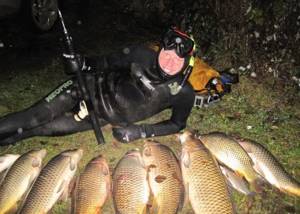
Of course, it is difficult to aim at fish in the water at night. Experienced fishermen recommend aiming at the body of the fish and not delaying the shot, as the carp can quickly evade and sink to the bottom. When using a harpoon, you need to shoot at the gills.
The harpoon will hook well and hold the fish. Hunting on ponds and lakes will be more successful if you first study the features of the reservoir and where the fish stay. Towards evening, the fish are found in shallow water, where they actually live close to the shore.
Spearfishing at night is a real thrill, and when diving into the boundless dark underwater kingdom, you cannot do without a good flashlight. For a hunter, this is an excellent opportunity to hunt and catch large specimens, because carp almost does not react to the light of a flashlight. But it is advisable to take into account the strength of the light and make it more diffused (lateral).
Of course, hunting carp at night is an impressive sight when small fish begin to dart in front of the glasses, looking like night lightning. When preparing for hunting, you should not forget about a spare underwater flashlight, so as not to be left without light in the underwater surface at night. It would be better if it were LED and light.

Today, this type of fishing is not considered poaching in our country, and with the arrival of twilight it is easier to catch carp (watch the video), when in search of feeding it begins to approach the very shore. You can hunt for carp day or night with a flashlight, unless, of course, other illegal methods are used for fishing.
Catching carp with a spring
Some amateur fishermen catch carp using a spring, and this method brings quite good results. Porridge, dough and plants are used as bait. A big role in such fishing is played by tackle, which is a steel spring made of wire. Several leashes are tied to it. The bait is placed inside the spring.
A spring is a type of feeder tackle. Only here the bait is not stuffed into the feeder, but is stuck around the spring like dough.
Fishing for carp with a spring is carried out in reservoirs where there is either no current at all or very weak. The tackle is thrown into the water at a distance of 40-60 m. Dough dumplings or a piece of cake are used as bait, which increases the likelihood of a catch.
You can cast a tackle with a spring using a spinning rod with a regular reel. In this case, the casting is good, and the line does not get tangled, since its excess is removed into the reel. In this way, carp are caught at night. The main thing when fishing this way is not to rush into hooking, since the fish may not cling to the hooks for a long time, even after catching the bait. You need to let it get hooked, after this happens, there will be a weak bite and then a long pull, and then you need to hook and fish out the carp.
An underwater hunter from Chelyabinsk talks about how to outwit carp and catch a giant catfish
The Chelyabinsk region is rich in lakes, and among other entertainments, South Urals residents enjoy spearfishing. Board member of the Ural Underwater Sports Club Sergei Kozin told the Access News Agency about the cunning carp, huge catfish and fighting pike, and also spoke about the rules of safe underwater hunting and the “trick” code of honor.
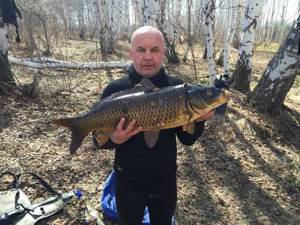
TALKS UNDER WATER
— How did you get acquainted with spearfishing?
— When we vacationed on ponds and rivers as children, we had a game - tag under water, where you had to dive far and deep and, thus, not be “greasy” by the driver. Even then, I unconsciously and quite effectively trained myself to hold my breath. The first time I tried swimming in full gear was when I was 40 years old, when my relative suggested going to Lake Sugoyak and shooting. Of course, the body of water cannot compare with the Caribbean or Red Seas, but I dived in and forgot about time. I swam for four hours and didn’t notice it.
I was very interested in spearfishing, but I couldn’t buy equipment right away, and I put the hobby off until later and even almost forgot about it. But then my wife and children, “racking their brains” about a gift for 45 years, gave me equipment - and it began. The first season, under the strict guidance of my friend, I swam in a shallow and fishy reservoir, and when winter came, I decided to take a spearfishing course. So, over the winter I managed to join the fraternity of underwater hunters, among whom I discovered serious mutual assistance and cohesion.
THE HUNTER'S INSTINCT IS NOT OUTLIED YET
— What do you experience when you hunt underwater?
— I get tremendous pleasure from being under water. There is such a plexus of sensations here. The clearer the water, the more beauty you can see. It happens that you stare at small fish that you will never shoot at.

Once I saw how a tench on Uvildy, with its head up, its tail like a broom, cleared the bottom of silt - I froze and watched it. I also got to watch pike hunt and feed. She grabs the perch by the tail, and then picks it up in her mouth and swallows it from the head. I met a muskrat and a beaver, a swan and ducks, watched how a large number of catfish, like a snake ball, made depressions at the bottom of the reservoir - a fascinating sight. These are all side elements of hunting, but incredibly interesting.

The main pleasure you get from the obtained trophy. After all, men are all hunters by nature, and this instinct has not yet outlived itself. Therefore, every effort is made to find large or rare fish. If an angler can only guess where a large trophy is sitting, then an underwater hunter can see it. I enjoy any dive into the water, but getting a trophy gives me much more emotions.
WILY CARP
— Tell us about the hunting process?
“It all starts with visually identifying the location of the fish. There is an opinion among experienced underwater hunters and fishermen that 90% of the fish are found in 10% of the reservoir. Each fish has its own strategy and its own tricks. Experience tells you where there is a high probability of finding this or that type of fish, but sometimes you meet it where you don’t expect it, which arouses even more interest.
— Do you have a favorite fish, the one you like to hunt the most?
— In our reservoirs it’s probably still carp. It is usually mined using a “dwelling” method, although active search is often used. You can identify a carp by various signs: the “muddy” and fresh holes that it leaves while getting food, the sharp sounds of shots, as we call them, when it runs away from our brother.
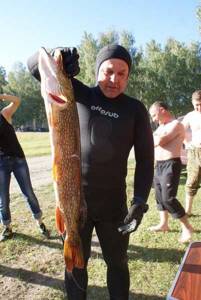
This is a very cautious and at the same time curious fish. For example, if he feels a slight movement of water along the side line for some time or hears reeds cracking and breaking, and then everything calms down, there is a high probability that the carp will want to check what moved there and where it went.
His curiosity has various manifestations. For example, I found traces of carp and am waiting for it in the haul-out area. He can come up from behind, see the object of his curiosity and go home, or he can parade in front of the hunter, sedately and slowly, looking into his mask. Sometimes you look for a carp for a long time, it’s as if everything around has died out, and when you shoot and it starts to fight on the line, out of the reeds, out of nowhere, its brothers begin to appear in large numbers. In my opinion, carp have more subtle instincts than many other fish, which makes the process of hunting it more interesting.
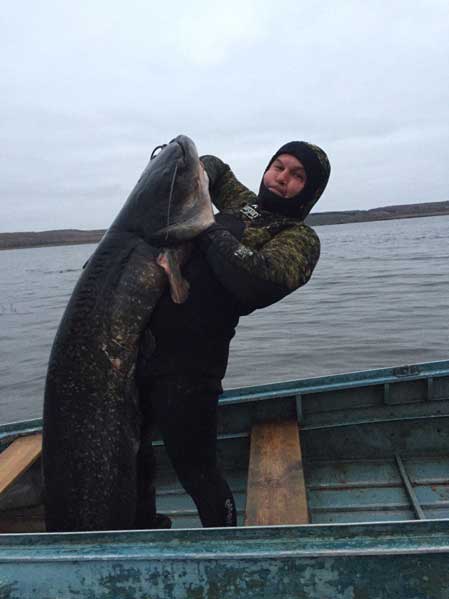
Pike, on the contrary, most often have to be looked for, because it is usually found in holes, dark spots, grass, under a roof if it is hunting, or on the bottom in the grass if it is resting. Sometimes she, guarding her territory, can come out to look at the impudent person who dared to swim into her territory. In general, a pike is a fighter that fights to the last, so the shot must be accurate, preferably in the head, so that it does not fall off and die later in the pond. If you do break it, you need to make every effort to find it and finish it off.
HUNTING HIGH
- Where is the best place to shoot to quickly kill a fish?
“The safest thing is to hit the head, but sometimes there is no way to target the prey, so you direct the shot so as not to miss and take the prey, sometimes they deliberately do not shoot in the head, for example, a large catfish, so that it does not die if it breaks or breaks the line.
— What do you use for hunting?
— Nowadays they hunt with pneumatic guns and crossbows. In the Chelyabinsk region, most underwater hunters use pneumatic guns because they have higher penetrating power with comparable sizes. The crossbow compensates for this shortcoming in length, however, poor visibility prevents the use of long weapons in the Ural lakes. Killing power is necessary for “armor-piercing” fish species, for example, carp, which are quite difficult to shoot - a short crossbow will simply injure the fish, and it will fall off the harpoon. For the same reason, I am against tees, which are popular among beginners; we use a single tip, also called a bullet.
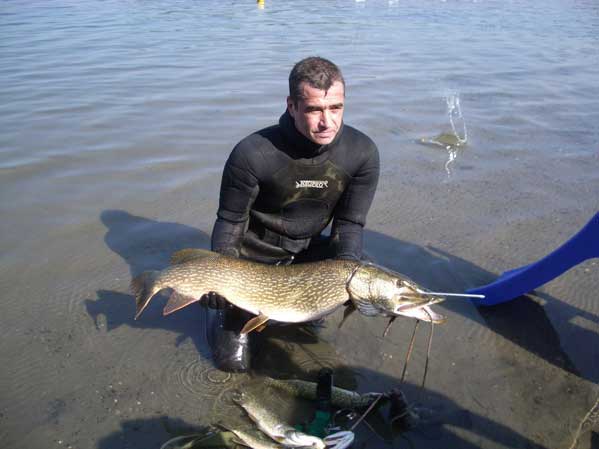
— How strongly do fish resist?
— Fighting with fish is not so much difficult as it is interesting. Carp pulls very powerfully at comparable sizes, carp pulls even more powerfully, and so does any large fish. The fish does not resist if its spine is broken or its head is hit. However, most fish resist, and this has its own hunting thrill.
My biggest trophy was on the Kama - a catfish weighing 42 kg.
IN GENERAL, I DON’T LIKE EATING FISH VERY MUCH...
—Have you tried hunting with a gun or a bow?
— This will probably sound paradoxical, but I feel sorry for the animals. My cousin is a real fan and I've gone with him a few times. Once, as a child, he told me that he shot a roe deer and saw a huge tear flowing from its open eye. I was only ten years old at the time, and this story greatly influenced me.
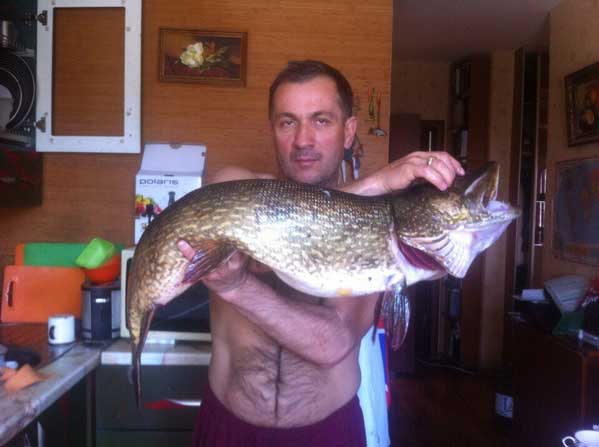
—What is fish for you? Is it food or a rival?
- Definitely not food - in general, I don’t really like eating fish. The main thing for me is the process. The larger the fish, the more difficult it is to catch and the more satisfaction you get when you manage to shoot it.
— How is hunting at sea different?
— Guys who often go hunting at sea practically cease to be interested in hunting in local lakes and rivers. There is good visibility and a much richer water world. Sea fish is a much more worthy opponent than river fish, and you have to catch it at decent depths of 30-40 meters. Personally, because of my work, I don’t get to go to the sea often, and I enjoy visiting local bodies of water.
RULES FOR A SUCCESSFUL HUNT
— What are the main components of successful spearfishing?
— Holding your breath is an important element, but not the main one. After all, there are guys who hunt in shallow waters and don’t breathe for only 20-30 seconds. In addition, it is not recommended to hold your breath as long as possible, so as not to get tired too quickly.
Probably the most important thing is the ability to find fish in a body of water, the ability to swim correctly and technically so that the movement of waves under water from a person is minimal and does not scare away the fish, knowledge of the habits of fish, the ability to predict their behavior. Also, of course, the ability to shoot accurately, the physical condition of the hunter, which allows him to explore a vast area of water, and much, much more.
— How dangerous is it to spearfish?
— Water is a foreign environment for humans, so you need to be afraid of it, and not neglect the safety rules developed by the underwater hunters community. There is even an expression: “There is an old “trick”, there is a brave “trick”. There are no brave and old tricks.” None of the trophies are worth our lives.
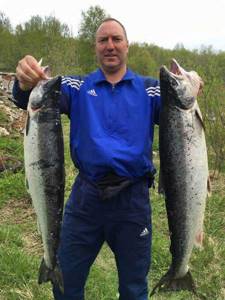
I advise all beginners to undergo training, because health, and sometimes life, is at stake. I advise you to initially hunt in the company of an experienced partner, or at least with a friend who can come to the rescue. Although hunting as a couple is fraught with the fact that beginners often injure their partner.
You shouldn’t panic underwater - adrenaline is produced, which instantly burns oxygen in the blood, so in emergency situations, for example, getting caught in a net, you need to control your emotions and act calmly.
CODE OF HONOR "Catch"
— Are there any rules for spearfishing? How many fish can you catch?
— According to the code of honor of an underwater hunter, you need to catch as much fish as you and your family can eat. To date, it has not been established by law how much fish is allowed to be caught in one hunt, so everyone decides for themselves.
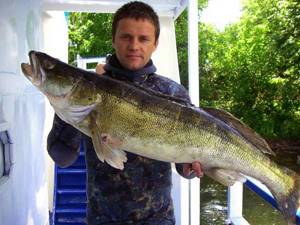
In addition, today's beginners begin to actively hunt at night because it is easier to catch fish at this time. They get used to easy prey and stop hunting during the day - with this approach, the population risks significantly decreasing. In addition, night hunting is often accompanied by a violation of safety rules, which this leads to, we have already said.
Interviewed by Sergei Borovinskikh, photo from the personal archive of Sergei Kozin
Tags:
hunting fishing Chelyabinsk news without pathos

